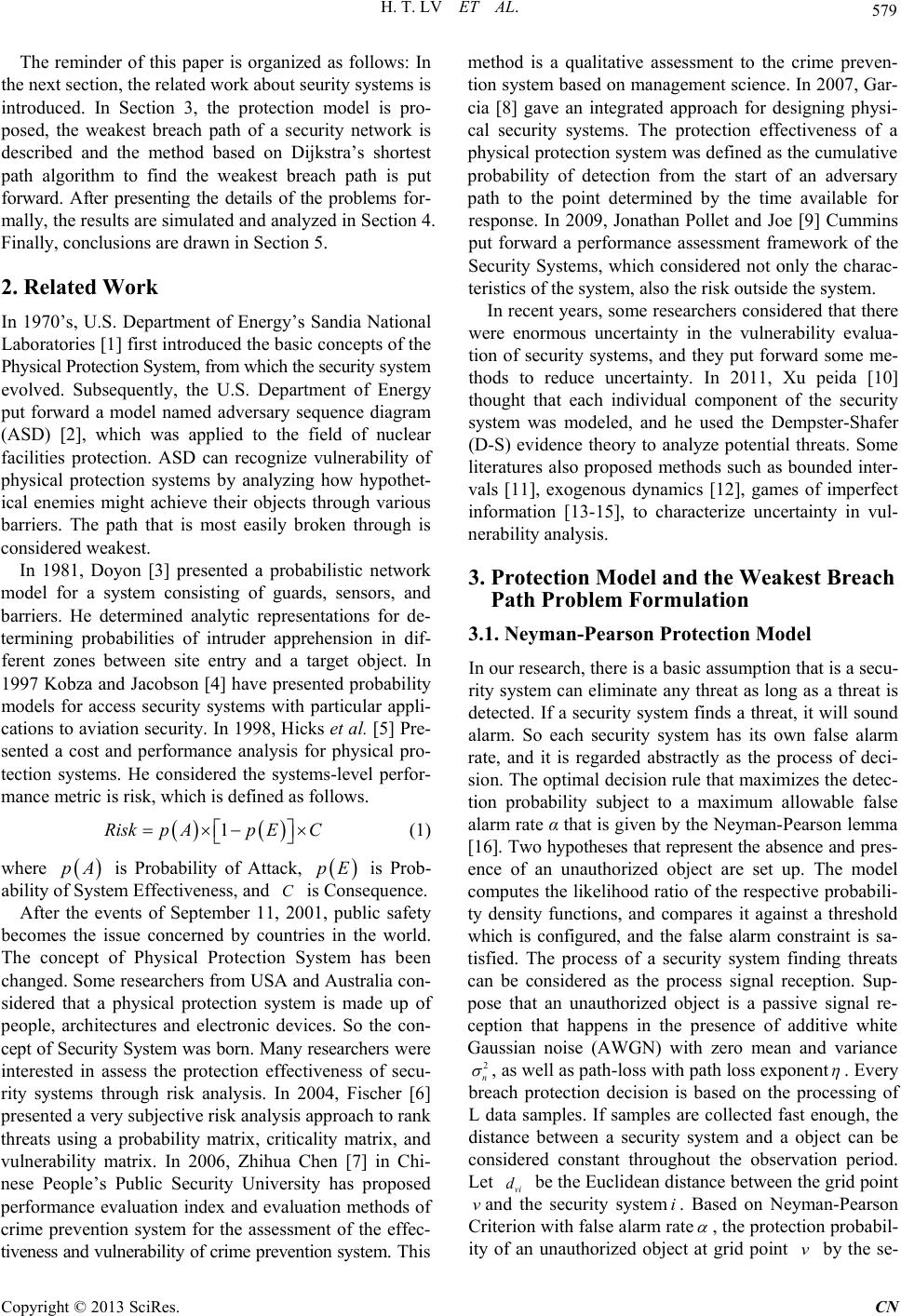
H. T. LV ET AL.
Copyright © 2013 SciRes. CN
The r eminder of this paper is organized as follows: In
the next section, the related work about seurity systems is
introduced. In Section 3, the protection model is pro-
posed, the weakest breach path of a security network is
described and the method based on Dijkstra’s shortest
path algorithm to find the weakest breach path is put
forward. After presenting the details of the problems for-
mally, th e results ar e simulated and analyzed in Section 4.
Finally, conclusions are drawn in Section 5.
2. Related Work
In 1970’s, U.S. Department of Energy’s Sandia National
Laboratories [1] first introduced the basic concepts of the
Physical Protection System, from which th e security system
evolved. Subsequently, the U.S. Department of Energy
put forward a model named adversary sequence diagram
(ASD) [2], which was applied to the field of nuclear
facilities protection. ASD can recognize vulnerability of
physical protection systems by analyzing how hypothet-
ical enemies might achieve their objects through various
barriers. The path th at is most easily broken through is
considered weakest.
In 1981, Doyon [3] presen ted a probabilistic network
model for a system consisting of guards, sensors, and
barriers. He determined analytic representations for de-
termining probabilities of intruder apprehension in dif-
ferent zones between site entry and a target object. In
1997 Kobza and Jacobson [4] have presented probability
models for access security systems with particular appli-
cations to aviation security. In 1998, Hicks et al. [5] Pre-
sented a cost and performance analysis for ph ysical pro-
tection systems. He considered the systems-level perfor-
mance metric is risk, which is defined as follows.
1RiskpAp EC= ×−×
(1)
where
is Probability of Attack,
is Prob-
ability of System Effectiven ess, and C is Consequence.
After the events of September 11, 2001, public safety
becomes the issue co ncerned by countries in the world.
The concep t of Physical Protection Syste m has been
changed. Some researchers from USA and Australia con-
side red that a ph ysical protection system is made up of
people, architectures and electronic devices. So the con-
cept of Security Sys te m was born. Many researcher s were
interested in assess the protection effectiveness of secu-
rity systems through risk analysis. In 2004, Fische r [6]
presented a very subj ectiv e risk analysis approach to rank
threats using a probability matrix, criticality matrix, and
vulnerability matrix. In 2006, Zhihua Chen [7] in Chi-
nese Peop l e ’s P ub lic Security Univ ersity h as proposed
performance evaluation index and evaluation methods of
crime prevention system for the assessment of the effec-
tiveness and vulnerability of crime prevention system. This
method is a qualitative assessment to the crime preven-
tion system based on management science. In 2007, Gar-
cia [8] gave an integrated approach f or designing physi-
cal security systems. The protection effectiveness of a
physical protection system was defined as the cumulative
probability of detection fro m th e star t of an adversary
path to th e point determined by the time available for
response. In 2009, Jonathan Pollet and Joe [9] Cummins
put forward a performance assessment framework of the
Security Systems, which considered not only the charac-
teristics of the system, also the ris k outsid e the system.
In recent years, some researcher s considered that the re
were enormous uncertainty in the vulnerability evalua-
tion of security systems, and they put forward some me-
thods to reduce unc er tain ty. In 2011, Xu peida [10]
thought that each individual component of the security
system w as modeled, and he used the Dempster-Shafer
(D-S) evidence theory to analyze potential threats. Some
literatures also proposed methods such as bounded inter-
vals [11], exoge n ous dynamics [12], games of imperfect
information [13-15], to characterize uncertainty in vul-
nerability analysis.
3. Protection Model and the Weakest Breach
Path Problem Formulation
3.1. Neyman-Pearson Protectio n Model
In our research, th er e is a basic assumption that is a secu-
rity system can eliminate any threat as long as a threat is
detected. If a security system finds a threat, it will sound
alarm. So each security system has its own false alarm
rate, and it is regarded abstractly as the process of deci-
sion. The optimal decision rule that maximizes the detec-
tion probability subject to a maximum allowable false
alarm rate α that is given by the Neyman-Pearson lemma
[16]. Two hypotheses that represent th e ab sen ce and pr e s-
ence of an unauthorized object are set up. The model
computes the likelihood ratio of the respective probabili-
ty density functions, and compares it against a threshold
which is configured, and the false alarm constraint is sa-
tisfied. The process of a security system finding threats
can be considered as the process signal reception. Sup-
pose that an unauthorized object is a passive signal re-
ception th a t happens in the presence of additive white
Gaussian noise (AWGN) with zero mean and variance
, as well as path-loss with path loss exponent
. Every
breach protection decision is based on the processing of
L data samples. If samples are collected fast enough, the
distance between a security system and a object can be
considered constant throughout the observation period.
Let
be the Euclidean distance between the grid point
and the security system
. Based on Neyman-Pearson
Criterion with false alarm rate
, the pro tection probabil-
ity of an unauthorized object at grid point
by the se-